
Happy 34th Anniversary + 13 days to my wonderful wife(who says that you can't celebrate it every day! Or keep celebrating the Integral Heart Family's record breaking fund raising last month for their wonderful children: https://www.marketforum.com/forum/topic/34791/
Scroll down and enjoy the latest comprehensive weather to the max...... occurring because of the natural physical laws in our atmosphere.
More Rains coming the next week+. Cool to mild temps..............very bearish the grains but the tariff bad news is crushing the markets.
Crop ratings dropped 1% for corn and beans Monday. This is a bit bullish. The increase in beneficial CO2 continues to result in crops doing much better than expected.
Temperatures continue to look cool in the Midsection, especially compared to how hot they looked in the middle of last week. This is bearish natural gas but has been dialed in.............for now. EIA report was neutral.
Frost threat for late next week is minimal today. Just too early in the year and not quite cold enough.............maybe low 40's in the colder spots.
Here are the latest hazards across the country.
Purple/Pink/blue on land is cold/Winter weather. Brown is wind, Green is flooding. Gray is fog. Reddish is a red flag advisory.
Go to the link below, then hit the location/county on the map for details.
https://www.spc.noaa.gov/ Go to "hazards"

Current Weather Map
| NCEP Days 0-7 Forecast Loop | NCEP Short-Range Model Discussion | NCEP Day 3-7 Discussion |



Wind map Press down on this on the left with your cursor!


Current Jet Stream

| Low Temperatures Tomorrow Morning |

Highs today and tomorrow.
Very cool in the Midwest by August standards!!
Heat dissapates in the south but builds in the West.



Highs for days 3-7:
Hot in the west. Pretty cool NorthCentral for highs.
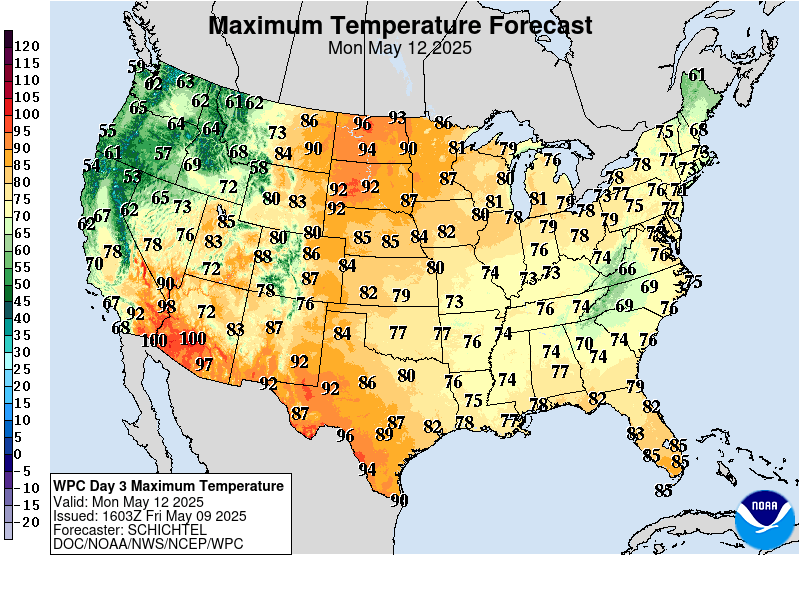
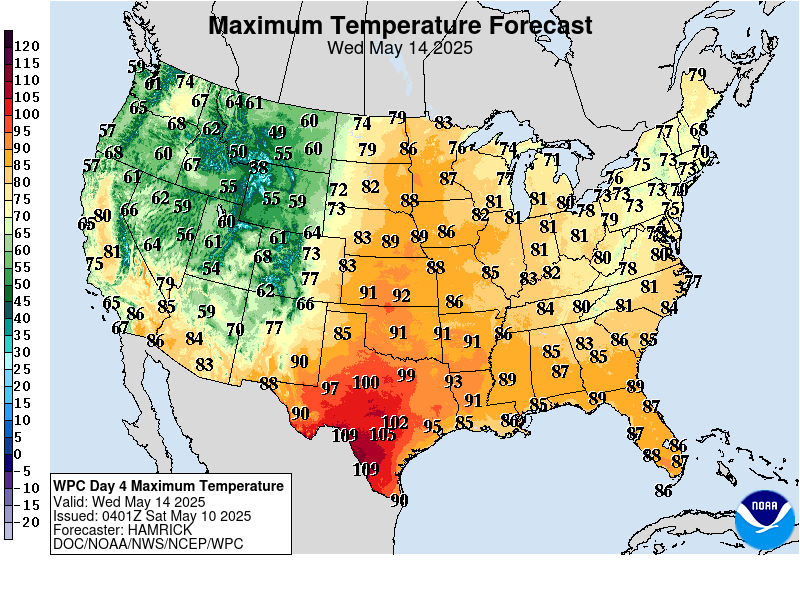
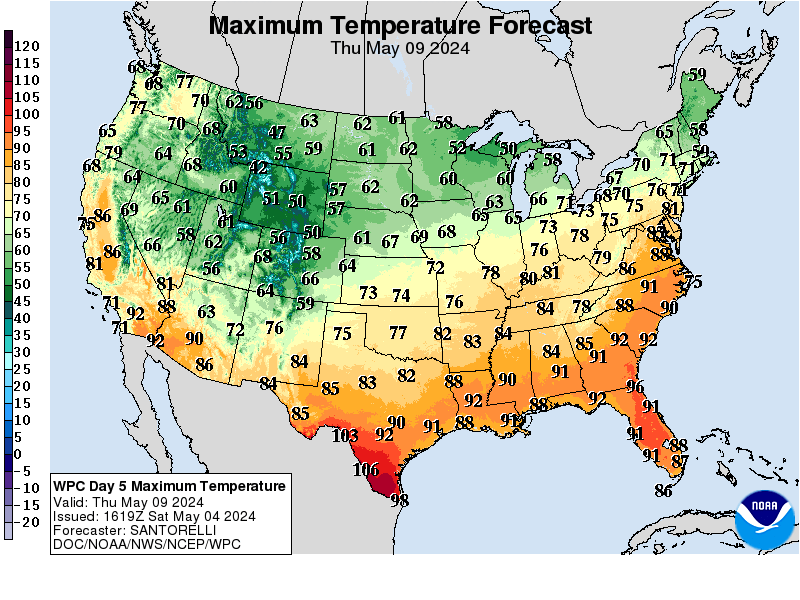
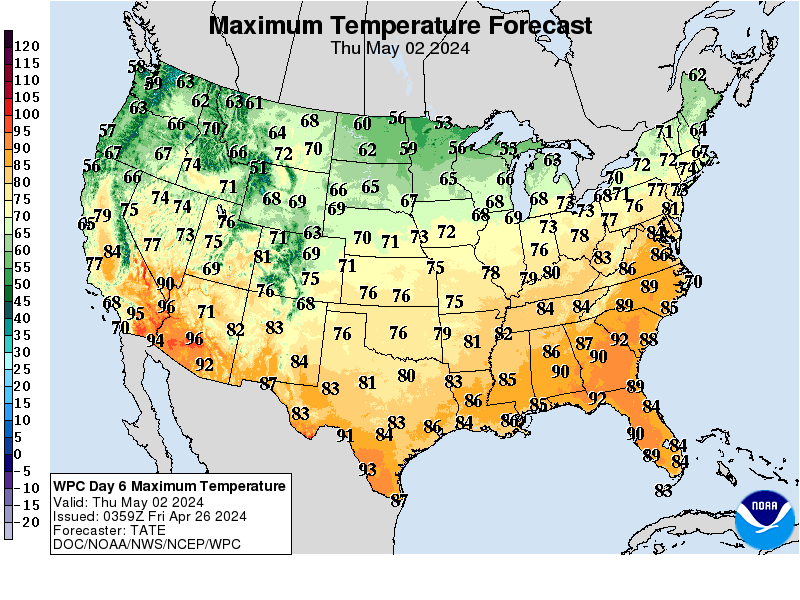
We have passed the peak in Summer temperatures based on climatological/historical averages by a month now.
The heat during this period will be shifted westward. Close to average Midwest/East but cool daytime temps NorthCentral.
https://www.wpc.ncep.noaa.gov/medr/medr_mean.shtml
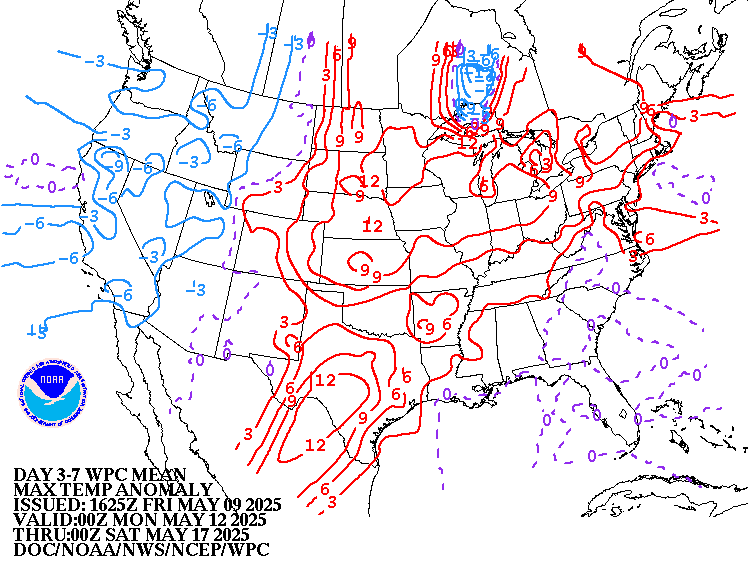
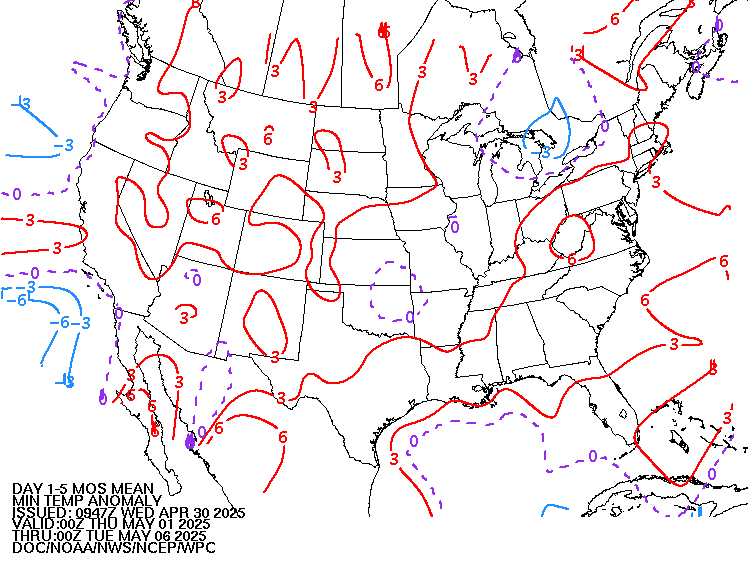
Weather maps for days 3-7 below
Reinforcing cold fronts with rain chances.
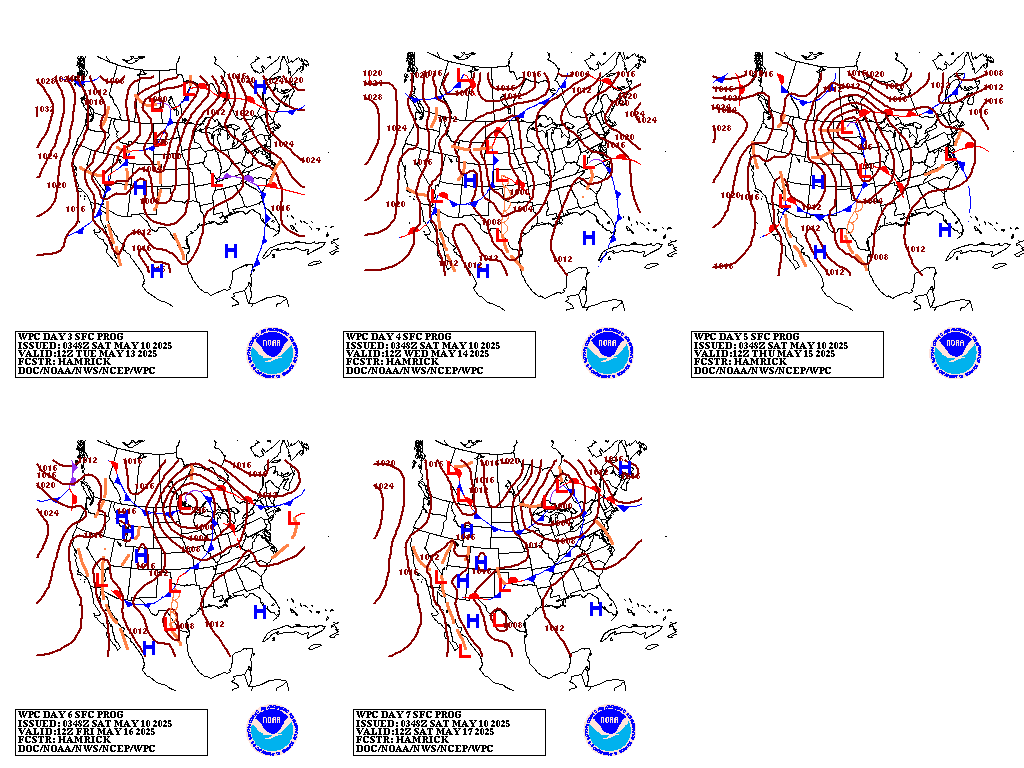
Liquid equivalent precip forecasts for the next 7 days are below.
Pretty wet by late August standards. Wettest in the Southwest Cornbelt.
Day 1 below:
http://www.wpc.ncep.noaa.gov/qpf/fill_94qwbg.gif?1526306199054
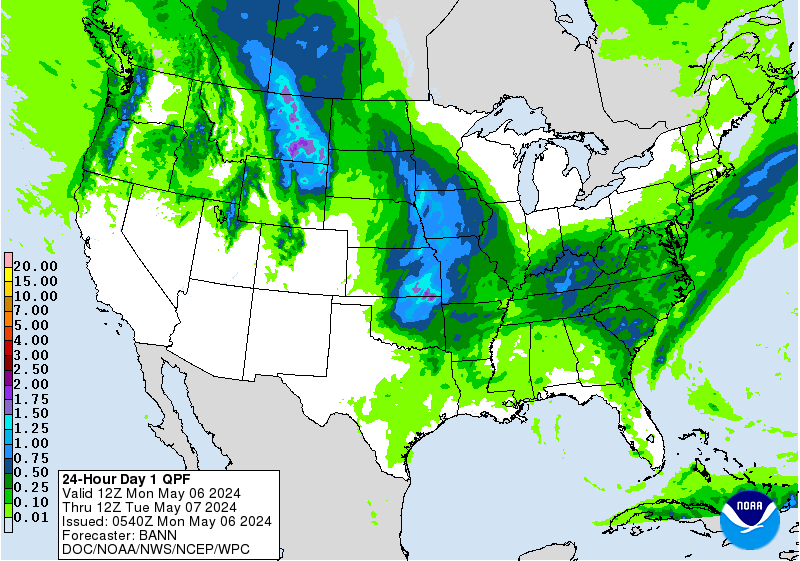
Day 2 below:
http://www.wpc.ncep.noaa.gov/qpf/fill_98qwbg.gif?1528293750112
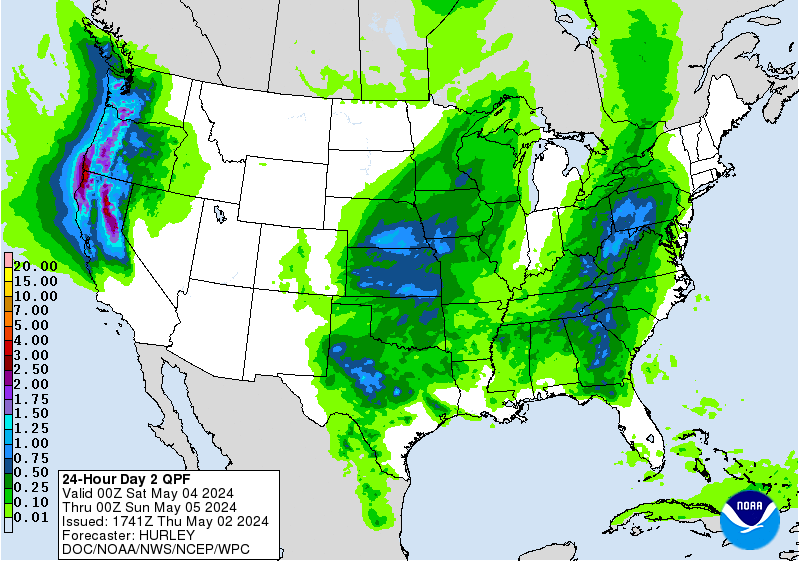
Day 3 below
http://www.wpc.ncep.noaa.gov/qpf/fill_99qwbg.gif?1528293842764
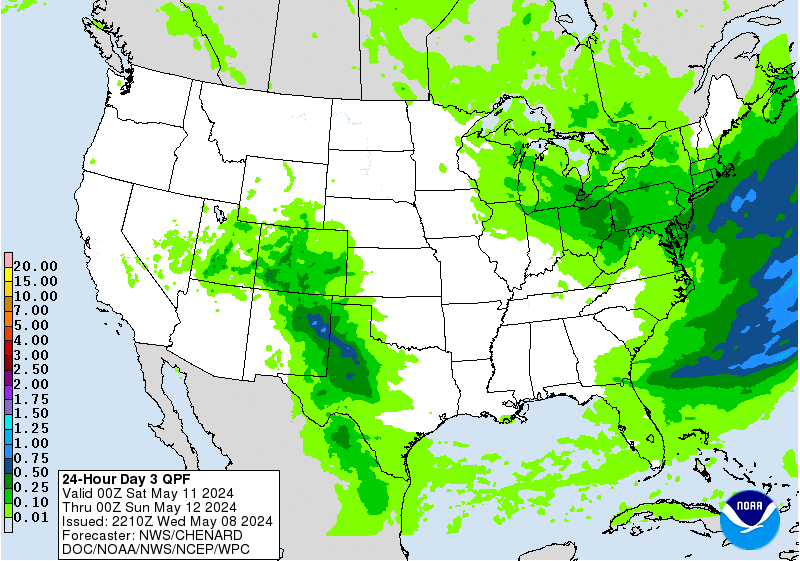
Days 4-5 below:
http://www.wpc.ncep.noaa.gov/qpf/95ep48iwbg_fill.gif?1526306162
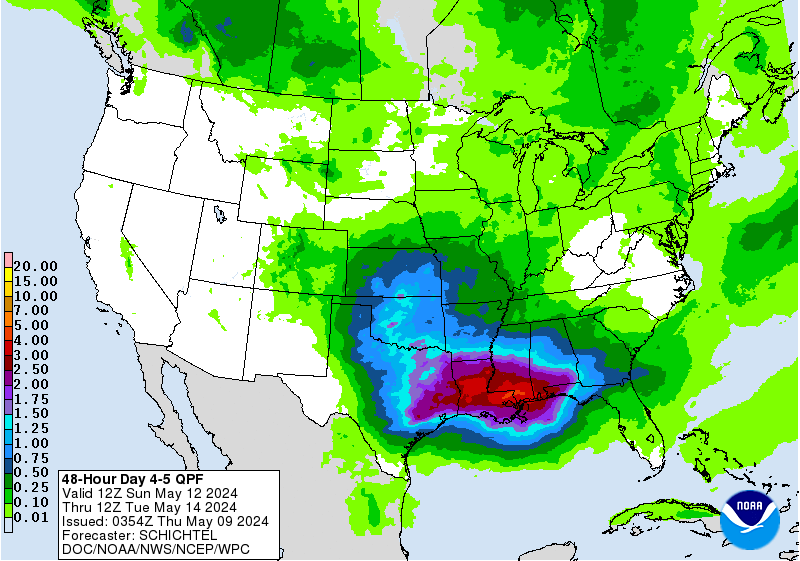
Days 6-7 below:
http://www.wpc.ncep.noaa.gov/qpf/97ep48iwbg_fill.gif?1526306162
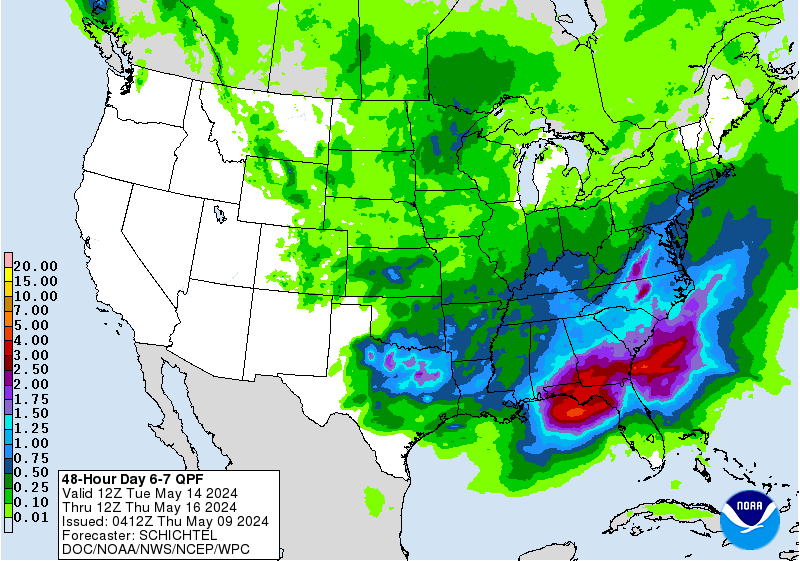
7 Day Total precipitation below:
http://www.wpc.ncep.noaa.govcdx /qpf/p168i.gif?1530796126
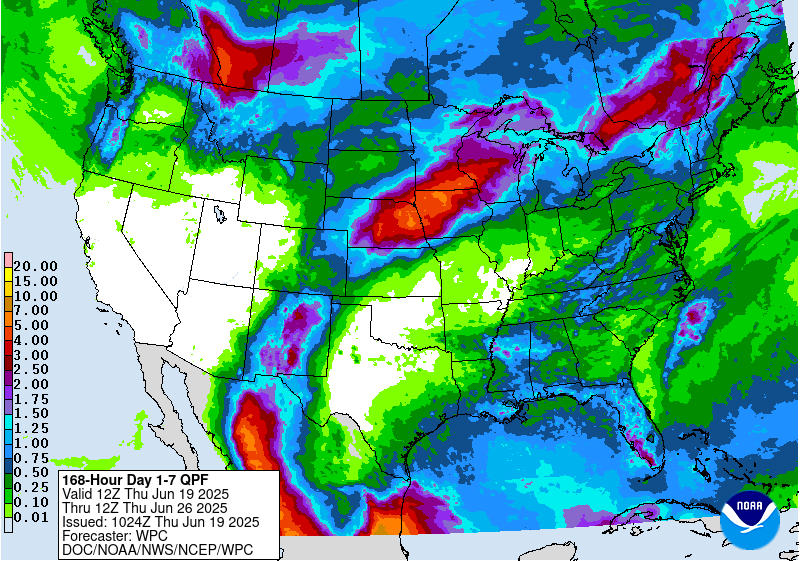
Last 24 hour precip top map
Last 7 day precip below that
https://www.wunderground.com/maps/precipitation/daily


Current Dew Points
Still Humid to the Ohio River today, drier air in the Upper Midwest on the way south.

Latest radar loop
http://www.nws.noaa.gov/radar_tab.php


| (3400x1700 pixels - 2.2mb) Go to: Most Recent Image |

Go to: Most Recent Image
You can go to this link to see precipitation totals from recent time periods:
https://water.weather.gov/precip/
Go to precipitation, then scroll down to pick a time frame. Hit states to get the borders to see locations better. Under products, you can hit "observed" or "Percent of normal"
+++++++++++++++++++++++++++++++++++++++++++++++
Precipitation compared to average for the last 7, 14, 30 and 60 days.
Some spots in Iowa and especially N/C Illinois have dried out!
Usually not updated for previous day until late the next day.
https://www.atmos.illinois.edu/~snodgrss/Ag_Wx.html




Soilmoisture anomaly:
These maps sometimes take a day to catch up to incorporate the latest data(the bottom map is only updated once a week).
A big chunk of the central and eastern Cornbelt has dried out but finally got some rains..........in many spots, not everywhere.
https://www.cpc.ncep.noaa.gov/products/Soilmst_Monitoring/US/Soilmst/Soilmst.shtml#
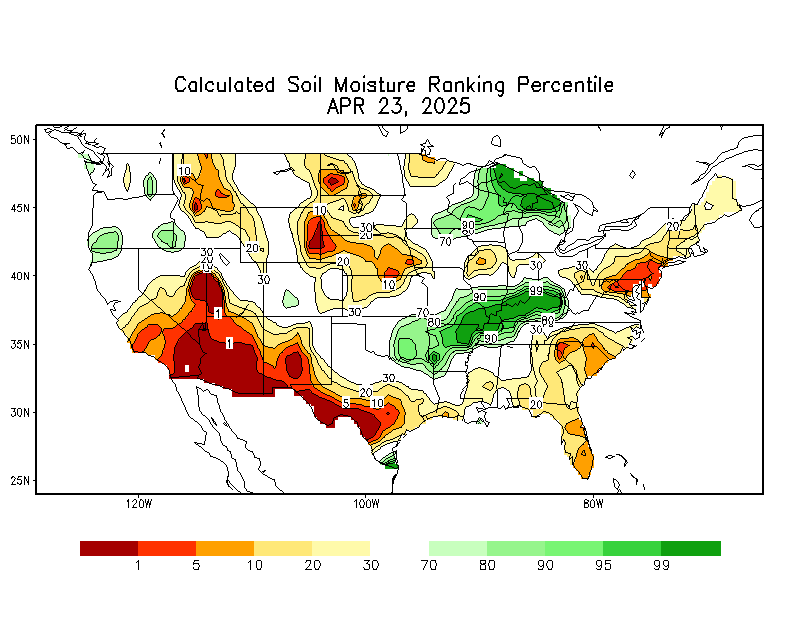
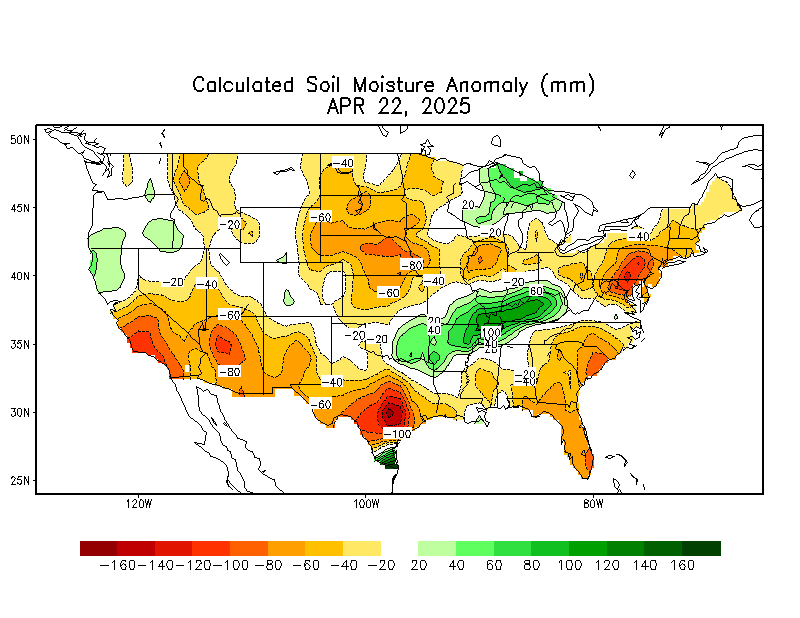
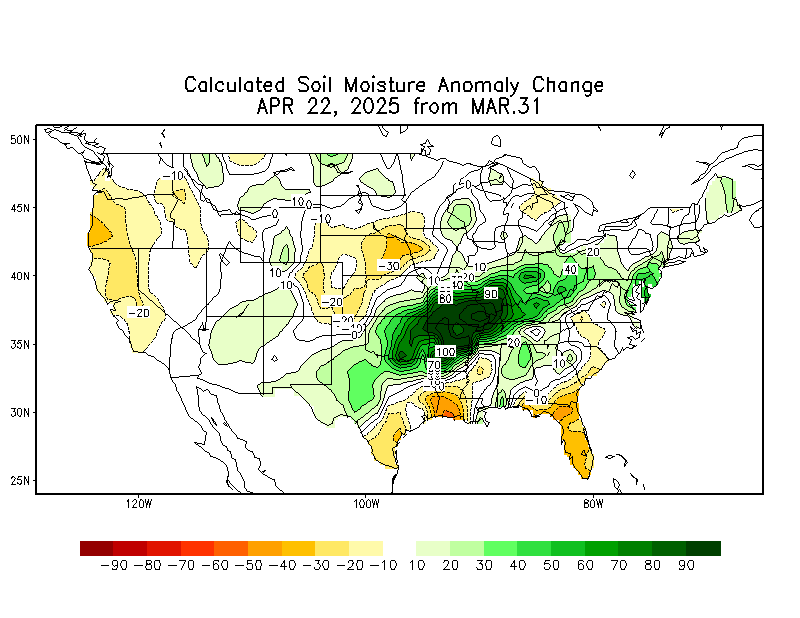
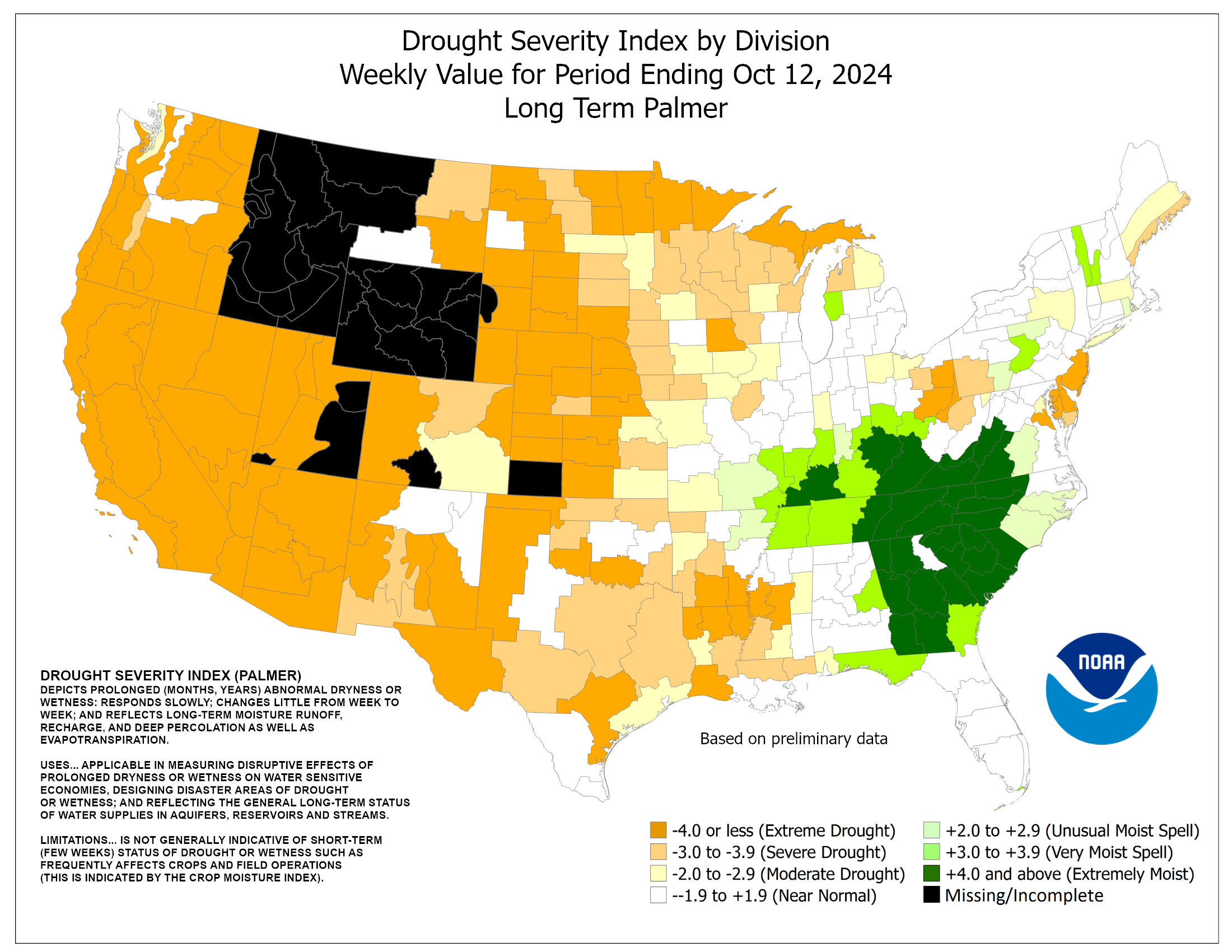
Latest: The first map below is the latest. The 2nd one is from last week. Note another increase in drought across a few spots in the central and eastern Cornbelt on the latest map but improvement in other spots from great rains.
In july/August, it's typical to see some increase in drought because of heat being a factor in evaporation, seasonally exceeding low rainfall during this month.
The amount of drought on next week's update will shrink a bit because of recent rains.
The map below is updated on Thursdays.
The market has turned into a rain makes grain market( any hot/dry in the forecast will be considered as bullish for the next month+).


The top map is the Canadian ensemble average, the maps below are the individual members that make up the average at the end of week 2.
+++++++++++++++++++++++++++++++++++++++++
Each member is like the parent, Canadian model operational model.......with a slight tweek/variation in parameters. Since we know the equations to represent the physics of the atmosphere in the models are not perfect, its useful to vary some of the equations that are uncertain(can make a difference) to see if it effects the outcome and how.
The average of all these variations(ensembles) often yields a better tool for forecasting. It's always more consistent. The individual operational model, like each individual ensemble member can vary greatly from run to run.........and represent an extreme end of the spectrum at times. The ensemble average of all the members, because it averages the extremes.............from opposite ends of the spectrum.........changes much less from run to run.
End of week 2....................0z ensembles:
Analysis starting from a week ago, ending with today:
Last week+ of analysis, starting with the day farthest in the past. This is an end of week 2 forecast!
Last
Wednesday: This particular batch of solutions is farther south with the upper level ridge and jet stream compared to yesterday......at the end of 2 weeks(The European model overnight was MUCH hotter though). Regardless, all the models agree on there being a very wet pattern around the periphery of the ridge associated with the active jet stream in the Midwest.
Thursday: A bit farther north with the heat ridge and hotter.
Friday: Farther south with the heat ridge today, as well as the strong zonal jet stream north of that, along the northern tier.
Saturday: Strong, zonal Jet stream continues to shift south, suppressing the heat ridge even farther south.............but that's on the mean. The solutions that go into this are completely different but the opposite patterns average out to this mean.
Sunday: 12z run. Interesting changes happening at the end of 2 weeks. Buckling jet stream potential. The 0z run suppressed the jet stream farther south, with the heat ridge pushed in that direction.........a recent trend. This last run, however, buckles the jet stream out West, into a deep trough on several solutions, which amplifies an upper level ridge in the East......much warmer. Other models have something closer to the opposite of this, so this run of the Canadian ensemble model will be taken with a grain of salt.
Monday: This model has more heat ridge in the Southeast to points northwest of that than the other models.
Tuesday: Still some heat ridge in the Southeast but the strong flow/jet stream farther north (active storm track) continues to sink a bit farther south.
Wednesday: Same trend. Heat ridge being suppressed on the mean, with strong jet stream sinking south..............but a couple of solutions want to buckle the jet farther west and amplify the heat ridge east.
Thursday: Huge disparity in location of where the strong jet stream will buckle(that carves out a deep trough which extends from much of Canada, into the US)!!! The solutions that do it farther west pump up a heat ridge in the East. Those that do it farther east, have the opposite.........an upper level trough in the East. The Canadian model has more ridging in the east (and south) than some the other models also vs its solution yesterday.
Friday: 12z run. Interesting to note the heat ridge on so many members in the Southcentral to Southeast US. Some wild solutions in Canada with a full latitude, major league upper level low/trough that extends south into the US. A much more pronounced northern stream could evolve out of this feature if the upper level ridging in far Western North America allows for more amplification downstream. That would be the first indicator for a legit major freeze threat with the right positions of those features..............but there can be no freeze without a ridge west/trough digging south downstream configuration/couplet.
360h GZ 500 forecast valid on Sep 07, 2019 12 UTC
0Z GFS Ensembles at 2 weeks:
Analysis, starting with the oldest, ending with the most recent:
Last Friday: Huge heat ridge in the US, especially south with very Powerful upper level low/trough in Canada.
Saturday: Where will the huge heat ridge be at the end of 2 weeks? Strong jet stream implied with potential anomalous flow and extreme temps/features in North America.
Sunday: Heat ridge could be anywhere at the end of 2 weeks based on this model.
Monday: This model is MUCH more impressive with the heat ridge in the East today.
Tuesday: Heat ridge over much of the country.
Wednesday: Heat ridge over the southern half of the country. Strong jet stream to the north, especially along the Canadian border.
Thursday: Same as Wednesday.
Friday: Huge change. Strong jet stream along the border is shown "buckling" into a trough in the Northcentral US area. Heat ridge suppressed, almost out of the picture.
Saturday: Some solutions continue to buckle the strong jet stream, digging it south of the Great Lakes, carving out a deep trough. Some less amplified and a few disagree completely.
Sunday: One position for buckling jet stream created trough is around the Great Lakes to maybe the Hudson Bay but huge uncertainty for this period.
Monday: Wide spread in solutions. Maybe an upper level trough in the middle? Not much confidence.
Tuesday: Upper level trough in the center of the country with more agreement, though location still varies, probably based on differences in speed of systems.
Wednesday: Upper level trough extending from Canada to Central US, heat ridge still in the far Southeast.
Thursday: Where will the deep trough in Canada and associated strong jet stream into at least the northern tier of the US be? Potential heat ridge farther south of this feature if it would stay west or track zonally along the US border. Solutions here strongly favor a buckling of the jet deeply into the central of the country.
Friday: How deeply into the US will the big trough in Canada penetrate? Where will this be at? Northcentral US looks likes the most likely.

GFS Ensemble mean(average of all the individual solutions above). The first map is a mid/upper level map. The 2nd one is a temperatures map at around 1 mile above the surface. These are anomalies(difference compared to average). The daily analysis starts with the oldest and ends with the latest.
Last Saturday: No powerful anomalies, partly because this is an average and some opposite extremes on different solutions cancel each other out, giving the false impression of docile, average weather over areas that will probably be fairly extreme.
Sunday: There are changes vs yesterday. New, positive anomaly in Northeast Canada and weaker anomalies in the US based on some solutions having a nice couplet/connection, reconnecting to cooler air from Canada flowing south.
Monday: Huge changes from Sunday. The positive anomaly is now in S/SE Canada, extending south from this model. Instead of this being cool from yesterday, the same location would have heat.
Tuesday: Very similar to Monday/yesterday.
Wednesday: Modest positive anomaly Hudson Bay to Great Lakes and off the Pac NW Coast.
Thursday: Positive anomaly off the Pacific NW Coast and in Northeast Canada.
Friday: Huge change. Positive anomaly still around Pacific Northwest but new negative anomaly Great Lakes...........much cooler under this solution!
Saturday: Center for the positive anomaly is now in SW Canada to just off the coast to the Gulf of Alaska with a downstream negative anomaly centered in the Great Lakes. This is usually a pretty good couplet for cool temperatures in the Midwest.
Sunday: Weaker positive anomaly off the West Coast of North America, weak negative anomaly around the Midwest. Not a strong signal for heat but neither is it especially cool.
Monday: The only significant anomaly is a positive one off the Pac NW Coast. Otherwise, near average and nothing strong to key off of. Probably a strong jet stream along the northern tier.
Tuesday: Positive anomaly again is off the Pac NW Coast. Slightly below average heights and cyclonic flow in the center of the country........so wet and cool.
Wednesday: Same as Tuesday. Positive anomaly off Pac NW Coast, modest positives along the East Coast, negative with trough in the middle of the country where is would be wet and cool.
Thursday: Similar to Wednesday. Positive anomaly off the Pac NW Coast. Negative anomaly from Hudson Bay, extended to a weakness in the Midwest. Slight positive in the Southeast, possible ridging ahead of the deep trough.
Friday: Still the modest positive anomaly off the Pac Northwest Coast. Upper trough to the east has so many variations, that it doesn't show up with that big of a negative departure in 500 mb heights average in any one place.
NCEP Ensemble t = 360 hour forecast
Latest, updated graph/forecast for AO and NAO here, including an explanation of how to interpret them...............mainly where they stand at the end of 2 weeks.
Previous analysis, with the latest day at the bottom for late week 2 period.
Last Saturday: AO is negative. NAO is negative and increasing a bit but now STAYS negative thru the end of 2 weeks, which is not as warm as the previous few days for that period. PNA is positive and dropping a bit.
Sunday: Potentially cooler implications for the end of the month. AO is still negative but the NAO stays negative now and at the end of 2 weeks, some solutions are decreasing the NAO value again. PNA stays a bit positive.
Monday: Big changes again, this time, possibly hotter. NAO increases to near 0 at the end of week 2 with a huge spread above and below(between models) indicating uncertainty. PNA goes from very positive, dropping to near 0........more favorable for heat in the eastern part of the country than yesterday.
Tuesday: AO a bit negative. NAO increases from negative to near zero with less spread than yesterday. PNA drops from positive to near zero. Indices near zero are not that powerful but warmth is favored.
Wednesday: AO negative. NAO increases to zero, then a big spread at the end of 2 weeks with slight lower bias. PNA drops towards 0 from being positive.
Thursday: AO negative. NAO increases to above zero now(with heat and upper ridging East) but then drops down a bit at the end of 2 weeks. PNA falls late in week 2.
Friday: AO a tad negative. NAO increases to 0 but at the end, big increase in spread with several plunging lower with possible pattern change to cooler.........much uncertainty. PNA drops from being positive.
Saturday: AO still negative. NAO is the big change. It stays negative and starts dropping again late week 2............increasing the chance for cooler temps. PNA drops from positive to negative.
Sunday: AO and NAO close to or just below 0. PNA drops to near 0. No help on providing powerful clues.
Monday: AO and NAO close to just below 0. PNA drops to near 0 from positive. No good clues.
Tuesday: AO and PNA close to 0. NAO a tad negative, favors cool in the Midwest.
Wednesday: All close enough to 0 for no clues.
Thursday: Changes. AO still near 0. Now we have a huge disparity/spread in the NAO at the end of 2 weeks because the pattern is very sensitive to where the trough/ridge couplet sets up from Canada to the US and points eastward and there is great disagreement on this. PNA increases, which favors the trough east and cool weather.
Friday: Today, all the indices are near 0, so no big help.
National Weather Service 6-10 day, 8-14 day outlooks.
My comments below are usually made hours before the afternoon update, starting with the oldest comment.
Last Friday: Much cooler in a large area. Probably still wet.
Saturday: Continued cooler and probably still pretty wet.
Sunday: Probably wet with near normal to cool temps Midwest, hot West.
Monday: Wet again with near normal temps to cool in the center and heat out West. Possible heat SouthEast too.
Tuesday: Wet again and cool in the middle. Some tools suggest very cool but not early freeze territory.
Wednesday: Wet again and very cool in the middle. A bit early in the year for a freeze but the Plains to Upper Midwest may have some 30's.
Thursday: Should be pretty wet(rains dry up in the 8-14 day period) and very cool in the middle and again, temps chilly enough for some 30's at the end of week 1 and start of week 2 in the Plains to Upper Midwest. How much warmth along the East Coast. The West Coast looks very warm to hot.
Friday: We should be drying out in many places. Temps remaining cool in the middle(but not as cool as week 2 progresses) with some heat around the edges.
Temperature Probability
| the 8-14 day outlooks ArchivesAnalogsLines-Only FormatGIS Data | |
Temperature Probability | |
 | |
Hot out West!! Chilly N.Plains to U. Midwest.
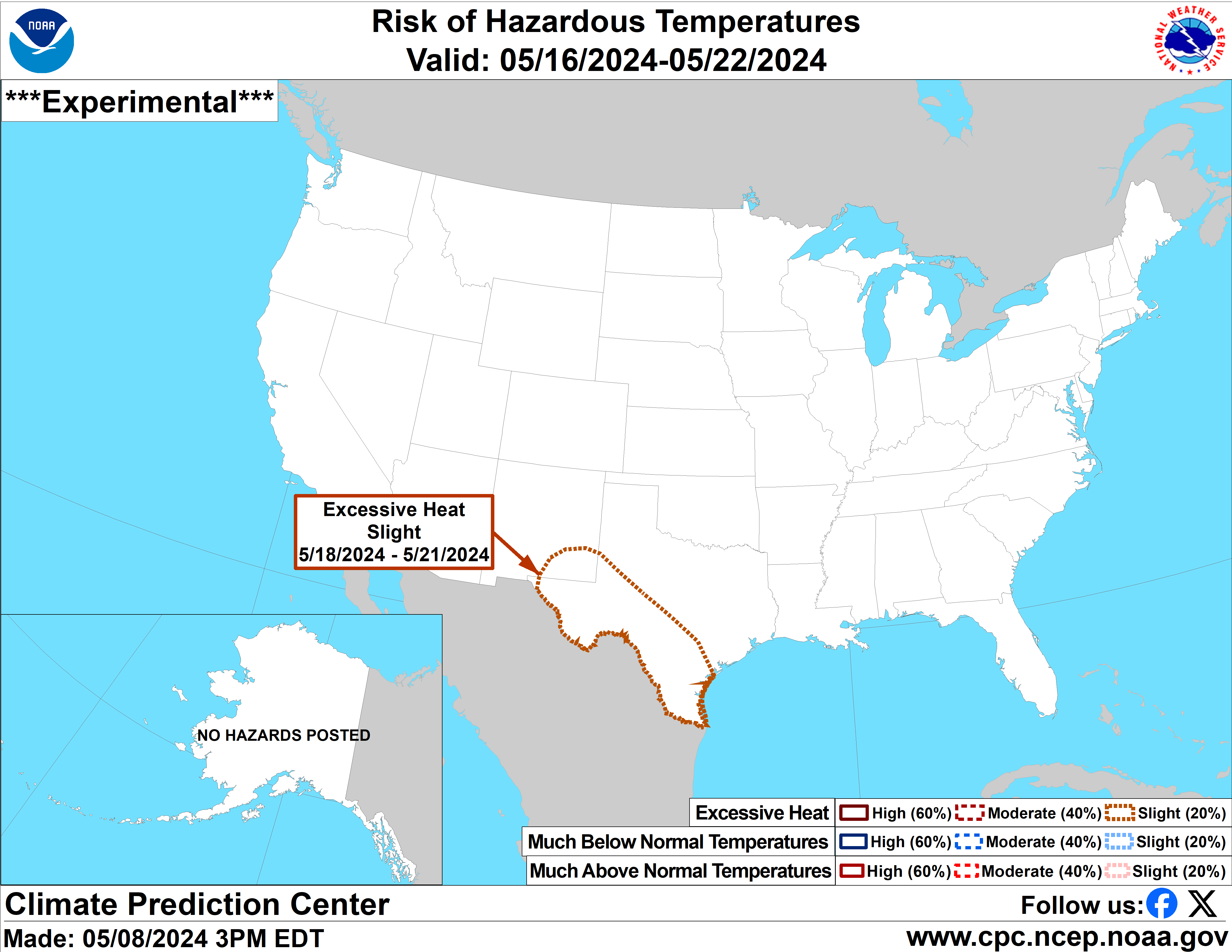 |
Cooler than average increases the chance for an early freeze in mid September.
| Week 3-4 Outlooks | ||
| Valid: 07 Sep 2019 to 20 Sep 2019 Updated: 23 Aug 2019 | ||
| Please provide comments using the online survey. | ||
Temperature Probability | Precipitation Probability (Experimental)  | |